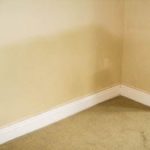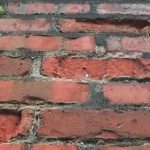The DIY Fix is reader supported. When you buy after clicking a link on our site, we may earn an affiliate commission.
Rising damp is one of the most serious types of damp. It can often be harder to diagnose and you are unlikely to even notice it occurring, until the problem has made significant progress into your property.
This is due to the nature of the problem. Rising damp is caused when water wicks up from the ground below your property. This means, you won’t know it’s an issue, until visible signs become present inside your house.
The most common sign of rising damp is wet tide marks on your walls, just above your floors and skirting boards.

Rising damp only occurs on the ground floor of your property. It is extremely rare for this type of damp to rise above 1m. Due to this it is impossible to get rising damp in the upstairs rooms of your property.
If the damp is on your ground floor and you can rule out any other issues, such as penetrating damp, condensation, or other leaks in your home, then it is possible that you are dealing with rising damp.
What problems can rising damp cause?
If rising damp is left untreated it can cause a variety of problems. These will all get worse overtime, so it is important that you act as soon as the problem is identified.
Below are some of the main problems rising damp can cause if it is left untreated:
- Ruining interior decoration – Paint will often start to blister, and flake of the walls and wallpaper will peel off.
- Damage to internal woodwork – This includes rotten skirting boards and architraves. As well as the swelling and warping of doors and door casings.
- Mould formation – Any type of damp in your property will provide a perfect environment for mould growth. This can be bad for your health if it is left untreated. Also, mould releases spores that can be easily transferred to different areas. This means it can quickly spread through your property.
- Unpleasant smell – As a result of damp and mould you will often get a bad odour in your home. This will also get worse the longer it is left, and it can even linger after the damp has been treated. In some cases, the smell has been likened to cat urine.
- Damage to structural timber – Over time, moisture can soak into structural timbers such as floor joists, which can lead to rot and mould. If these are left untreated, they can become dangerous and even cause floors to fall through.
- Damage to brickwork and mortar – The masonry of your property is also at risk. Overtime water and salts can cause damage to the brickwork and surrounding mortar. This can cause issues such as spalling, crumbling bricks and blown pointing. These issues can open your home to further issues from penetrating damp.
Making sure its rising damp
As you can see, rising damp can cause a whole host of cosmetic and structural problems.
All these problems are likely to get worse the longer damp is left untreated. However, it is important that you make sure you are treating the right problem.
Whilst rising damp is serious, it is also far less common than other forms of damp. This often leads to it being misdiagnosed.
Penetrating damp is far more common and can be cause by variety of different problems and defects. This could include:
- Damage to bricks and pointing. This can often be easy to identify with a visual inspection.
- Ground level above the DPC outside the property. This could include the ground itself, as well as decking, and any other surfaces or structures added to the property, after its original construction.
- Water bridging the cavity. This could be less obvious and may be more difficult to identify.
Other potential issues could be the result of internal leaks, or even bad cases of condensation.
These are all potential issues, and even if you discover the problem isn’t rising damp, it still needs treating. If any form of damp is left untreated it will usually get worse over time.
This will always result in more work and financial expense when it comes to fixing the problem. By acting quickly when you first spot the problem, you are likely to save a good amount of time and money.
What if you’re not sure its rising damp?
As we have already mentioned, rising damp is often misdiagnosed. If you have carried out some visual inspections and still aren’t sure, then you should consider having an expert examine the problem.
Damp can find its way into your home in a variety of ways. If you don’t know what to look for, you can often miss signs. These are signs that a trained damp professional would easily spot.
You can usually have a professional damp specialist visit your home and carry out a full damp inspection and damp survey. There will sometimes be a small fee, although many companies will offer a completely free survey.
The best thing to do if you are considering hiring a professional, is to get multiple opinions. This wont cost you any extra and you are more likely to get the best price on any work required.
The best way to get multiple quotes, is by using a comparison service that works with local damp proofing companies.
The advantage with this approach, is the companies are all vetted by the comparison service. They also get reviews from previous customers. This means, you always know your hiring a highly rated professional.
To see our favourite comparison service and get up to 5 local damp proofing quotes click here
Ways to treat rising damp
If you do discover that rising damp is the issue, you have a few ways to deal with this problem. There are DIY damp proofing solutions, or you can choose to let a professional do the work.
Common rising damp treatments include:
- DPC injection creams – As the name suggests, this is a cream that can be injected into the mortar to form a waterproof barrier. This is a common DIY method, and you can see some of the leading DPC injection kits by clicking here. Alternatively, you can hire a professional to carry out the job for you.
- DPC injection rods – This is a similar process to the injected creams. Holes are drilled into the mortar at regular intervals. Following this, damp proofing rods are inserted into the holes, where they soak up moisture and release a water repellent, this seeps deep into the pours and capillaries of the masonry.
- Replacing the original DPC – This process is much more complicated and requires the skill of a professional trades person. To replace the original DPC, you need to remove bricks to insert a new damp proof course. This is a highly skilled job and involves structural work. This should never be carried out by an amateur DIY’er.
- Electro osmotic damp proofing – This method uses electricity to stop rising damp. A small amount of electricity is introduced into the wall just above ground level. This repels the rising moisture with a positive electric charge. You can see how this actually works with a simple child’s science experiment here. In this experiment, negatively charged particles attract water. With electro damp proofing, the opposite is true and the positive charge repels the water. Again, this is a more specialist technique and will need the assistance of a professional.
The first two methods can be done by anyone with a reasonable level of DIY skills. For the last two, you will need to hire an expert to carry out the work.
Conclusion
As you can see, rising damp can be a serious issue. If it is left untreated, it can lead to more serious problems over time.
However, it can also be tricky to diagnose. This means that you may require the assistance of a trained damp proofing professional. If this is the case, make sure you compare quotes and do some research on the companies you are talking with.
When using a comparison service, you can talk with multiple companies and see all their previous customer feedback.
By doing this, you will be able to find the best company based on past customer feedback, as well as a much better price than if you approached them directly (not through a comparison service).




